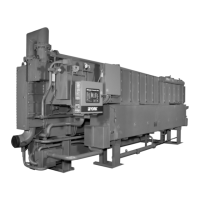22 JOHNSON CONTROLS
FORM 155.19-EG3 (1011)
via the MicroComputer Control Center Panel:
• Return and leaving chilled water temperatures
• Return and leaving condenser water temperatures
• rst-stage generator pressure
• Refrigerant temperature
• Solution temperature
• Indication of refrigerant/solution/purge pump operation
• Operating hours
• Number of starts
• Number of Purge Cycles (last 7 days and total cumula-
tive)
• rst-stage generator temperature
• Steam valve actuator potentiometer position (in %)
Capacity Control – The MicroComputer Control Center
Panel shall auto matically control the input steam ow rate
to maintain the programmed leaving chilled water setpoint
for cool ing loads ranging from 20% to 100% of design.
The input steam ow rate shall also be adjustable manu-
ally from the MicroComputer Control Center Panel to any
setting between minimum and maximum when automatic
op eration is not desired and when steam input is not being
inhibited by a specic operating condition.
Safety Shutdowns – Panel shall be pre-programmed to
shut the unit down and close “safety shutdown” contacts
under any of the following conditions:
• Refrigerant or solution pump thermal or current over-
land
• Low refrigerant temperature
• rst-stage generator high temperature or pressure
• Loss of chilled water ow
• Power failure (when “Automatic Restart after Power
Failure” option is not utilized)
• Incomplete dilution cycle operation due to one of the
following conditions:
• Power failure
• Solution/refrigerant pump overloads
• Low refrigerant temperature
• Loss of chilled water ow
• External auxiliary safety shutdown
All safety shutdowns will require unit to be manually
restarted.
Whenever a safety shutdown occurs, the Millennium
Control Panel shall record the following information and
store it in memory (or communicate it to remote printer):
day and time of shutdown; reason for shutdown; type of
restart required (automatic restart is displayed, manual
restart is implied); all system operating information dis-
played just prior to shutdown.
Warning Conditions – MicroComputer Control Center
Panel shall close warning contacts and generate a unique
warning message whenever one of the following operating
conditions is detected:
• Low refrigerant temperature
• High generator temperature or pressure
• High or low entering condenser water temperature
• Purge pump current overload
• Faulty solution dilution temperature sensor
Cycling Shutdowns – Control Center Panel shall be
pre-programmed to shut unit down whenever one of the
following conditions is detected:
• Loss of condenser water ow
• Low leaving chilled water temperature
• Power failure (when “Automatic Restart after Power
Failure” option is selected)
Cycling shutdowns shall permit unit to automatically restart
when pre-programmed thresholds are reached. Follow-
ing a cycling shutdown, cycling shutdown con tacts shall
close and cycling shutdown messages shall be displayed
and recorded in a similar fashion as safety shutdown
messages.
Programmable Setpoints – The following parameters
shall be programmable directly from the key pad:
• Leaving chilled water temperature in 0.1°F (0.1°C)
increments
• Remote reset chilled water temperature range (see
detail below)
• 7 day schedule for unit start/stop (see detail below)
• Holiday schedule for unit start/stop (see detail below)
• Pull down demand (see detail on following page)
• Time clock/calendar date
Remote reset signals for leaving chilled water tempera ture
setpoint shall be 1 to 11 second pulse width modu lated
(PWM) as standard. An optional eld installed card le
and card shall be available to permit the following reset
signals to be used in lieu of a 1 to 11 second PWM signal:
4-20mA, DC, 0-10VDC, contact closure 7-day scheduling
shall permit one unit start and stop to be made each day
at discrete times as desired over a seven day calendar
basis through the use of an integral timeclock. In addition,
a separate holiday schedule shall be programmable up
to one week in advance.
Guide Specications - continued

